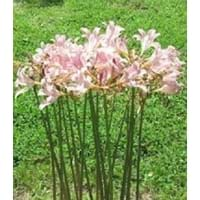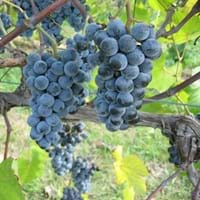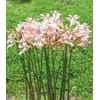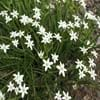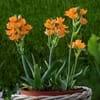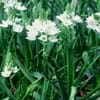Life Span
Perennial
Perennial
Type
Bulb or Corm or Tuber
Fruit
Origin
Not Available
Northeastern United States
Types
Not Available
Not Available
Habitat
Subtropical climates, Sunny Edge
Forests, meadows, River side, Riverbanks
USDA Hardiness Zone
Not Available
4-9
AHS Heat Zone
Not Available
9-2
Sunset Zone
21,22
2b, 3a, 3b, 6, 7, 8, 9, 14, 15, 16, 17, 18, 19, 20, 21, 22, 23
Habit
Clump-Forming
Vining/Climbing
Minimum Height
Not Available
Flower Color
White, Orange, Pink, Hot Pink, Coral, Crimson, Lavender, Ivory
White
Flower Color Modifier
Bicolor
Bicolor
Fruit Color
Not Available
Blue, Dark Blue, Black
Leaf Color in Spring
Green, Gray Green, Dark Green
Green
Leaf Color in Summer
Light Green
Green
Leaf Color in Fall
Several shades of Green
Orange, Gold, Bronze
Leaf Color in Winter
Light Green
Light Green
Leaf Shape
Long linear and narrow
Lobed
Plant Season
Spring, Summer, Fall
Spring, Summer, Fall
Sunlight
Full Sun, Partial Sun
Full Sun, Partial Sun
Type of Soil
Not Available
Clay, Loam, Sand
The pH of Soil
Not Available
Acidic, Neutral, Alkaline
Soil Drainage
Well drained
Well drained
Bloom Time
Late Summer, Early Fall, Fall
Late Spring, Early Summer, Summer
Tolerances
Drought
Drought
Where to Plant?
Ground
Ground
How to Plant?
From bulbs
Seedlings
Plant Maintenance
Medium
Medium
Watering Requirements
Needs very little water
Average Water Needs, Needs Very high moisture, Sprinkle water over foliage
In Summer
Lots of watering
Lots of watering
In Spring
Moderate
Moderate
In Winter
Average Water
Average Water
Soil pH
Not Available
Acidic, Neutral, Alkaline
Soil Type
Not Available
Clay, Loam, Sand
Soil Drainage Capacity
Well drained
Well drained
Sun Exposure
Full Sun, Partial Sun
Full Sun, Partial Sun
Pruning
Cut back the foliage when the plants die back naturally, Remove damaged leaves, Remove dead branches, Remove dead leaves
Remove damaged leaves, Remove dead branches, Remove dead leaves
Fertilizers
All-Purpose Liquid Fertilizer
All-Purpose Liquid Fertilizer, Apply N-P-K
Pests and Diseases
Pests and diseases free
Beetles, Flea Beetles, Leaf Hoppers, Leaf Rollers, Mealy bugs, Red blotch
Plant Tolerance
Full Sun
Deer resistant, Drought, Heat And Humidity
Flowers
Showy
Insignificant
Flower Petal Number
Single
Single
Foliage Texture
Medium
Coarse
Foliage Sheen
Matte
Glossy
Attracts
Bees, Butterflies, pollinators
Not Available
Allergy
Unknown
Not Available
Aesthetic Uses
Beautification, Cottage Garden, Informal Hedge, Mixed Border, Showy Purposes
Not Used For Aesthetic Purpose
Beauty Benefits
Not Available
Not Available
Environmental Uses
Air purification, Deer resistant, Food for insects
Air purification
Medicinal Uses
Unknown
Miscellany, Poultice
Part of Plant Used
Bulbs
Fruits, Leaves, Sap
Other Uses
bulb used as starch
Used as a dye
Used As Indoor Plant
No
No
Used As Outdoor Plant
Yes
Yes
Garden Design
Cutflower, Feature Plant, Mixed Border
Edible, Fruit / Fruit Tree, Vine
Botanical Name
LYCORIS
VITIS labrusca 'Concord'
Common Name
Naked Ladies, Spiderlily, Surprise Lily
Concord Grape, Fox Grape
In Hindi
surprise lily
Concord Grape
In German
Überraschung Lilie
Concord Grape
In French
Lycoris squamigera
Concord Grape
In Spanish
Lycoris squamigera
uva Concord
In Greek
surprise lily
σταφυλιού Concord
In Portuguese
surpresa lírio
uva Concord
In Polish
niespodzianka lilia
Concord winogron
In Latin
surprise lily
Concordia pluribus
Phylum
Not Available
Tracheophyta
Class
Liliopsida
Magnoliopsida
Order
Asparagales
Vitales
Family
Amaryllidaceae
Vitaceae
Clade
Angiosperms, Monocotyledonous
Angiosperms, Eudicots, Rosids
Tribe
Not Available
Not Available
Subfamily
Amaryllidoideae
Not Available
Number of Species
Not Available
Season and Care of Surprise Lily and Concord Grape
Season and care of Surprise Lily and Concord Grape is important to know. While considering everything about Surprise Lily and Concord Grape Care, growing season is an essential factor. Surprise Lily season is Spring, Summer and Fall and Concord Grape season is Spring, Summer and Fall. The type of soil for Surprise Lily is Not Available and for Concord Grape is Clay, Loam, Sand while the PH of soil for Surprise Lily is Not Available and for Concord Grape is Acidic, Neutral, Alkaline.
Surprise Lily and Concord Grape Physical Information
Surprise Lily and Concord Grape physical information is very important for comparison. Surprise Lily height is Not Available and width Not Available whereas Concord Grape height is 300.00 cm and width Not Available. The color specification of Surprise Lily and Concord Grape are as follows:
Surprise Lily flower color: White, Orange, Pink, Hot Pink, Coral, Crimson, Lavender and Ivory
Surprise Lily leaf color: Green, Gray Green and Dark Green
Concord Grape flower color: White
- Concord Grape leaf color: Green
Care of Surprise Lily and Concord Grape
Care of Surprise Lily and Concord Grape include pruning, fertilizers, watering etc. Surprise Lily pruning is done Cut back the foliage when the plants die back naturally, Remove damaged leaves, Remove dead branches and Remove dead leaves and Concord Grape pruning is done Remove damaged leaves, Remove dead branches and Remove dead leaves. In summer Surprise Lily needs Lots of watering and in winter, it needs Average Water. Whereas, in summer Concord Grape needs Lots of watering and in winter, it needs Average Water.
